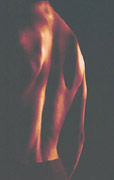



 |
 |
 |
 |
||
Arnica Montana, native to Europe, Siberia and North West N. America, is also known as Mountain Daisy, Leopard's Bane, European Arnica and The Accident Remedy.
The active components are sesquiterpene lactones, which are known to reduce inflammation and decrease pain. Other active principals are thymol (an essential oil), flavonoids, inulin, carotenoids and tannins.
Arnica works by stimulating the activity of white blood cell to disperse trapped fluids from bumped and bruised tissue, joints and muscles. Counter-irritant properties, (isomeric alcohols) increases local circulation and helps temporary relieve deep-seated painful irritation. Due to this, it may raise blood pressure. Arnica has anti-bacterial and anti-inflammatory qualities that can reduce pain and swelling, improving wound healing.
 Arnica is a help aid for bruises, traumas, injuries, muscular tiredness, stiffness, and pain, bleeding from injuries and black eyes. The plant is also helpful for arthritis, burns, ulcers, eczema, acne and can even ameliorate old injuries whether rubbed directly on the skin or taken in tablet form.
Arnica is a help aid for bruises, traumas, injuries, muscular tiredness, stiffness, and pain, bleeding from injuries and black eyes. The plant is also helpful for arthritis, burns, ulcers, eczema, acne and can even ameliorate old injuries whether rubbed directly on the skin or taken in tablet form.
Arnica comes in many forms such as tablets, cream, lotion, massage oil, spray, ointment, and salve. It is important to know that the skin should not be broken when applying any of these products. Arnica taken internally can be toxic, except when consumed in the form of homeopathic tablets, the minute traces then are not harmful, but beneficial.
Arnica is widely used and recommended by athletes, stunt personnel and people who regularly put physical stress on their bodies, but it is a useful part of any first aid kit.
 You can prepare you own tincture of this herb:
You can prepare you own tincture of this herb:
Use a clear glass container,
Combine 1/2 liter (one pint) of 70% alcohol
50 grams (2 ounces) of freshly picked flowers.
Seal the jar tightly, let it stand for at least one week in the sun or warm place.
Filter the mixture.
To use, soak a cotton cloth in the tincture and place cloth where needed.
Repeat as necessary
To store, keep the tincture in a sealed container out of direct sunlight
This article is not a substitute for medical advice or treatment for any medical conditions. You should promptly seek professional medical advice if you have any concern about your health or physical condition, and you should always consult your physician before following the recommendations presented here.
|
|
||
|
© Melt Magazine 2001
|
||